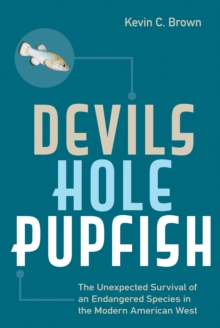
National Parks Book Series, 5 Volume Set Paperback / softback
by George Bristol, Don Lago, Jonathan Foster, Hal Rothman, Joseph P. Sanchez
Edited by Char Miller
Part of the America's National Parks series
Paperback / softback
Description
The first comprehensive study of the park, past and present, Death Valley National Park probes the environmental and human history of this most astonishing desert.
Established as a national monument in 1933, Death Valley was an anomaly within the national park system.
Though many who knew this landscape were convinced that its stark beauty should be preserved, to do so required a reconceptualization of what a park consists of, grassroots and national support for its creation, and a long and difficult political struggle to secure congressional sanction.
In time, Death Valley came to be seen as one of the great natural wonders of the United States, and was elevated to full national park status in 1994.
The history of Death Valley National Park embodies the many tensions confronting American environmentalism. Lake Mead National Recreation Area examines the creation, characteristics, and tribulations of the first United States National Recreation Area.
It also addresses the National Park Service’s historic role in managing reservoir-based recreation in a uniquely arid region.
First named the Boulder Dam Recreation Area, this parkland was created in 1936 by a memorandum of agreement between the National Park Service and the U.S.
Bureau of Reclamation. Over the course of its existence, the area has served as a model for a subsequent system of National Recreation Areas.
The area’s extreme popularity has, in combination with changing public attitudes regarding preservation and safety, presented the National Park Service with tremendous challenges in recent decades.
Jonathan Foster’s examination of these challenges and the responses to them reveal an increasingly anxious relationship between the government, the public, and special interest groups in the American West. The Grand Canyon has long inspired deep emotions and responses.
For the Native Americans who lived there, the canyon was home, full of sacred meanings.
For the first European settlers to see it, the canyon drove them to great exploration adventures and Wild West dreams of wealth.
The canyon also held deep importance for America’s pioneer conservationists such as Teddy Roosevelt, John Muir, and Aldo Leopold, and it played a central role in the emerging environmental movement.
Grand Canyon: A History of a Natural Wonder and National Park is a mixture of great storytelling, unlikely characters, and important ideas.
The book will appeal to both general readers and scholars interested in seeking a broader understanding of the canyon. Coronado National Memorial explores forgotten pathways through Montezuma Canyon in southeastern Arizona, and provides an essential history of the southern Huachuca Mountains.
This is a magical place that shaped the region and two countries, the United States and Mexico.
Its history dates back to the expedition led by Conquistador Francisco Vásquez de Coronado in 1540, a mere forty-eight years after Columbus’ first voyage.
Before that time Native Americans occupied the land, later to be joined by Spanish and Mexican period miners and ranchers, prospecting entrepreneurs, missionaries, and homesteaders.
Much has been written about southwestern Arizona and northeastern Sonora, and in many ways this book complements those efforts and delivers details about the region’s colorful past. Bristol takes readers on a journey through the history of Glacier National Park, beginning over a billion years ago from the formation of the Belt Sea, to the present day climate-changing extinction of the very glaciers that sculpted most of the wonders of its landscapes.
He delves into the ways in which this area of Montana seemed to have been preparing itself for the coming of humankind through a series of landmass adjustments like the Lewis Overthrust and the ice ages that came and went.
Bristol recounts how a renewed conservation ethic fostered by such leaders as Emerson, Thoreau, Olmstead, Muir, and Teddy Roosevelt took hold.
Their disciples were Grinnell, Hill, Mather, Albright, and Franklin Roosevelt, and they would not only take up the call but rally for the cause.
These giants would create and preserve a park landscape to accommodate visitors and wilderness alike.
Information
-
Item not Available
- Format:Paperback / softback
- Pages:1064 pages, 99 black & white photographs, 4 maps. Five part book set
- Publisher:University of Nevada Press
- Publication Date:01/08/2017
- Category:
- ISBN:9781948908009
Information
-
Item not Available
- Format:Paperback / softback
- Pages:1064 pages, 99 black & white photographs, 4 maps. Five part book set
- Publisher:University of Nevada Press
- Publication Date:01/08/2017
- Category:
- ISBN:9781948908009










